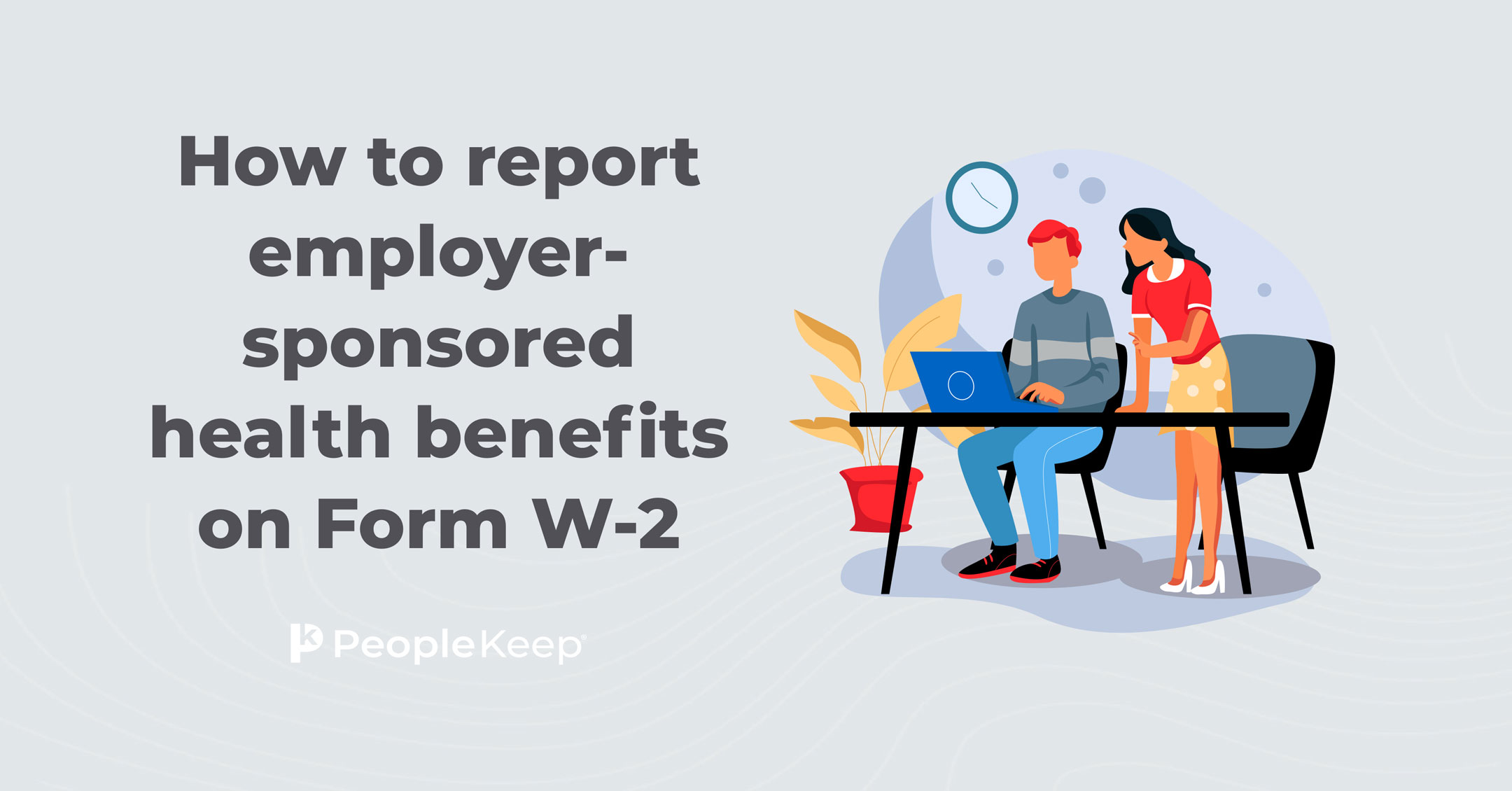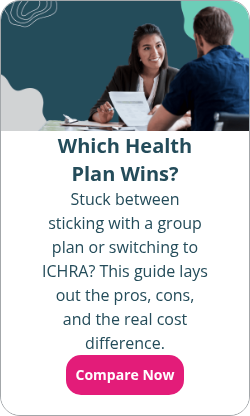What are level-funded health benefits?
By Elizabeth Walker on April 3, 2024 at 10:54 AM
Small to medium-sized businesses (SMBs) often look for creative alternatives to traditional health insurance to offer their employees an affordable and comprehensive health benefit. One option some employers may consider is a level-funded health plan.
While you may be unfamiliar with level-funded health plans, they aren’t a new concept. Because of their fixed price and potential cost savings, they’ve become popular for employers with limited healthcare budgets. In fact, a recent KFF survey found that 32% of small employers offered a level-funded plan in 20231.
As with all employee benefits, it’s essential to understand the ins and outs of these plans before enrolling. This blog will explain how level-funded health plans work, how they differ from other health plans, and go over another fixed-cost health benefit option that may suit your needs.
Takeaways from this blog post:
- With level-funded health plans, employers pay insurers a fixed monthly amount for medical claims, stop-loss insurance, and administrative fees. These plans offer budget predictability and potential cost savings, making them an attractive option for employers looking to manage healthcare expenses.
- While there are several advantages, there are potential drawbacks, such as a learning curve, risk of excessive employee’ claims, and the uncertainty of receiving a surplus refund. You may also experience annual rate hikes.
- Health reimbursement arrangements (HRAs) are self-funded plans that allow employees to use a monthly allowance for various medical expenses and receive tax-free reimbursements. Unlike level-funded health plans, HRAs give employers complete control over their health benefit with less financial risk.
What are level-funded health benefits?
A level-funded health plan is a policy where employers pay a fixed amount of money to an insurance company every month to cover administration fees, medical claim payments for employees, and stop-loss insurance premiums. They then share the risk of the plan alongside the insurer. Most insurers consider these types of plans a form of self-funded insurance.
There are various health insurance plans available with level-funded policies. Depending on your annual budget, you can add customizable benefits to your plan, like telemedicine, mental health services, wellness perks, family benefits, and more.
Because you pay a fixed or “level” amount, these plans allow you to manage your budget better and save money. This makes them an appealing option for SMBs, startup organizations, or employers with a limited benefits budget who want more predictable costs. However, level-funded plans aren’t available in every state because some locations regulate stop-loss insurance2.
How do level-funded health benefits work?
As mentioned above, employers pay an insurer a fixed combined monthly price for their employees’ claims, stop-loss insurance, and administration fees. But let’s break level-funded plans down piece by piece.
Level-funded plans first work like self-funded health insurance. Employers pay into the plan’s claims fund to cover the cost when an employee submits an eligible medical claim for payment. There’s typically an annual claim threshold per person. Depending on your budget, this may cost $10,000 to $100,000 per employee. You’re only responsible for paying out claims covered by the amount in the claims fund.
If your employees’ medical claims exceed the amount in your claims fund, your stop-loss policy will kick in to cover the excess. While other self-funded plans can add stop-loss insurance to their policies, level-funded plans don’t work without it. This type of insurance protects you from expensive claims until the plan year ends. Like other forms of insurance, you pay a monthly premium for stop-loss coverage.
At the plan year's end, you may receive a surplus refund or credit toward a renewed policy if your actual claim costs are lower than you initially estimated. If your claims are higher than you estimated at the beginning of the year, your premium may renew at a higher rate.
The last portion of the monthly fee you’ll pay for your level-funded plan is for administrative services. Insurance companies or third-party administrators offer employers administrative services to help them manage their policies. These services include help paying medical claims, customer service, plan participant onboarding, and other administrative tasks.
What are the pros of level-funded health benefits?
Level-funded health policies may be an excellent option for SMBs looking to offer affordable but comprehensive benefits. Let’s go over some of their advantages.
Some advantages of level-funded health plans include the following:
- Your monthly costs can be predictable: Employers with a level-funded plan pay a fixed monthly payment, regardless of how many claims your employees submit. This gives you peace of mind of knowing exactly how much to budget every month.
- You may receive a claims refund: Not only are your monthly costs more predictable, but your ability to accurately estimate the cost of your employees’ medical claims can result in a potential refund at the plan year's end. Tracking your employees’ claims and offering wellness programs as add-ons can give you a better estimate and increase the likelihood of receiving a claims refund.
- You may have a lower monthly premium: While traditional health plans can use several factors, like location and industry, to calculate a premium rate, level-funded plans only use your enrolled group members to determine your rate. Typically, if your workforce is primarily young and healthy and doesn’t submit many claims, your premiums will be lower on average compared to fully-insured health plans.
- You have greater insights on costs: With a level-funded plan, your insurer can provide monthly data reports to help you understand how to optimize your plan costs. For example, you can see how many employees are using the benefit, how many claims employees made, how much each claim payment was, etc. The more data you have, the better you can customize your plan so you and your employees get the most out of it.
- You’re exempt from some regulations: Federal law considers level-funded health plans a self-funded policy. Therefore, they don’t have to comply with all of the Affordable Care Act (ACA) requirements that other health plans must follow. Because they can follow fewer compliance regulations, these policies may be easier to manage for some employers.
What are the cons level-funded health benefits?
Implementing a level-funded plan may help you save on your employees’ healthcare costs. However, you need to consider the potential downsides before getting started.
The following are some drawbacks to level-funded health plans:
- There’s a learning curve: Traditional group health plans are popular mainly because they’re familiar to employers and employees. If it’s your first time using a level-funded plan, the learning curve of stop-loss insurance, claim payments, and other administrative tasks can be overwhelming and not be worth the hassle for small employers.
- They can cost more than other self-insured plans: Even though you’ll have a monthly fixed price, the price is the combined total of your claims fund, administrative costs, and stop-loss plan premiums. Any add-ons can also increase your payment. Therefore, the total monthly price may be more expensive overall than other self-funded health plans and health benefits, like health reimbursement arrangements (HRAs).
- Exceeding your claims comes with a price tag: If you underfund your claims account and exceed your claims, your stop-loss insurance will cover the excess. But there’s a catch. Your insurance carrier will consider your excess claims when you renew your level-funded plan the following year. Depending on your healthcare budget and how you estimate your claims, this type of policy may be unsustainable for you in the long term.
- You’re not guaranteed a claims refund: While the idea of receiving a refund may be a potential upside, you’re only likely to receive a refund if your claim estimate at the beginning of the year is accurate. Some carriers only issue a refund if you agree to renew your plan, and other insurers require you to split the refund with them as a fee for their services. So, it may not be quite the financial incentive that you expect.
How do level-funded health benefits compare to fully-insured and self-insured health plans?
While they have similar components, a level-funded plan isn’t the same as a fully-insured or self-insured policy. With a fully-insured plan, employers pay a fixed premium rate to a health insurance carrier to cover plan participants. Insurers pay medical claims according to the plan details, and employees must pay any required out-of-pocket costs, like deductibles and copayments, for covered services.
In contrast, with a standard self-insured plan, you assume total control, including all financial risk, for providing health benefits to your employees. This means you're responsible for the fixed and variable costs of the plan—like third-party or software administrator expenses—and other fees. You’re also on the hook for your employees’ claim costs, which can vary monthly. But you can buy a stop-loss insurance policy to reduce the risk of higher-than-expected claims.
Level-funded plans are a combination of fully-insured and self-funded plans. Like a fully-insured plan, you share some financial responsibility with the insurer in the form of fixed premiums. While you take on extra costs, like claims accounts, stop-loss insurance, and administrative expenses, your insurers will often provide you with resources to manage these tasks.
Essentially, a level-funded plan is for employers looking to break away from fully-insured plans but aren’t ready for the full responsibility of managing a self-insured plan on their own.
How an HRA can provide your employees with a comprehensive health benefit for a fixed monthly cost
If you don’t think a level-funded plan is right for you, there’s another health benefit that offers flexibility, customization, and affordability: the HRA.
An HRA is an IRS-approved, formal health benefit that you can use to reimburse your employees for individual health insurance premiums and qualified out-of-pocket medical expenses, like chiropractic care, prescription glasses, hospital fees, and more.
HRAs have the flexibility of a self-insured health insurance plan without the financial risk or complicated administrative tasks. When designing your benefit, you set a monthly allowance to offer your employees that they can use on medical costs. Once an employee buys a medical item or service and submits an eligible expense, you approve the amount and reimburse them tax-free up to their allowance amount.
HRAs are a great solution for employers of all sizes, locations, and budgets for several reasons. Unlike health savings accounts (HSAs), employers don’t pre-fund HRAs, and they have no cash value. This means you only pay your employees in the form of reimbursements after they submit proof of an incurred eligible expense.
Your benefit costs are predictable with HRAs because once you set your monthly allowance, your employees can’t exceed it. Better yet, they’re tax-advantaged. HRA funds aren’t subject to federal or state income taxes; contributions and reimbursements are also payroll tax-free for employers. HRA reimbursements are also income tax-free for employees as long as their health plan provides minimum essential coverage (MEC).
Lastly, HRAs are employer-owned, meaning any unused HRA funds stay with you if an employee leaves your company.
The following are the three most popular types of HRAs that PeopleKeep offers:
- The qualified small employer HRA (QSEHRA) is for small employers with fewer than 50 full-time equivalent employees (FTEs) who don’t offer a group health policy. The IRS sets annual maximum contribution limits for QSEHRA. But there are no minimum limits, so it’s budget-friendly. For eligibility, you must offer it to all your W-2 full-time employees. Part-time workers can also participate if they receive the same allowance as your full-time employees. Reimbursements are income-tax-free as long as they have MEC.
- The individual coverage HRA (ICHRA) is like the QSEHRA, but it’s for employers of all sizes and has no maximum contribution limits. You can set different allowance amounts based on 11 employee classes, making it customizable for every organization’s needs. Only employees with a qualified individual health plan can participate in the benefit, meaning those with a group plan or alternative coverage can’t use it. Lastly, applicable large employers (ALEs) can use an ICHRA to satisfy the employer mandate, depending on affordability.
- The group coverage HRA (GCHRA), also called an integrated HRA, is for companies of all sizes that offer a traditional group health plan. Only employers enrolled in the group health plan can participate. Employees can receive GCHRA reimbursements for eligible expenses not fully paid for by their group health plan. GCHRAs have no maximum contribution limits and can vary allowance amounts based on seven employee classes.
Unlike fully insured or level-funded health plans, HRAs are customizable enough to work for every employer’s budget while keeping them complete control over their health benefits plan. And because employees can choose their own coverage and medical expenses, they’re an excellent way to attract and retain talent and stay competitive in the labor market.
Conclusion
Finding a budget-friendly health benefit that gives employees enough value can be difficult for SMBs. Luckily, there are a variety of options to help you achieve that goal. Level-funded health coverage can be an enticing option if you’re looking for more predictable health insurance costs with some of the structure of fully insured plans.
However, by allowing your employees to choose their own medical plan and reimbursing them for their expenses with an HRA, you’ll have even greater flexibility and control over your health benefit—without breaking the bank.
1. https://www.kff.org/report-section/ehbs-2023-summary-of-findings/
Check out more resources
See these related articles

How to report employer-sponsored health benefits on Form W-2
Unsure how to report employer-sponsored health benefits on your Form W-2? This blog has clear explanations and examples to help you navigate the process.

Can I have an HRA and an FSA at the same time?
Learn if you can have an HRA and an FSA at the same time. Understand the rules, benefits, and how these accounts can work together for healthcare costs.

What is an HRA?
Learn what a Health Reimbursement Arrangement (HRA) is, how it works, and how it benefits both employers and employees in managing healthcare costs.



